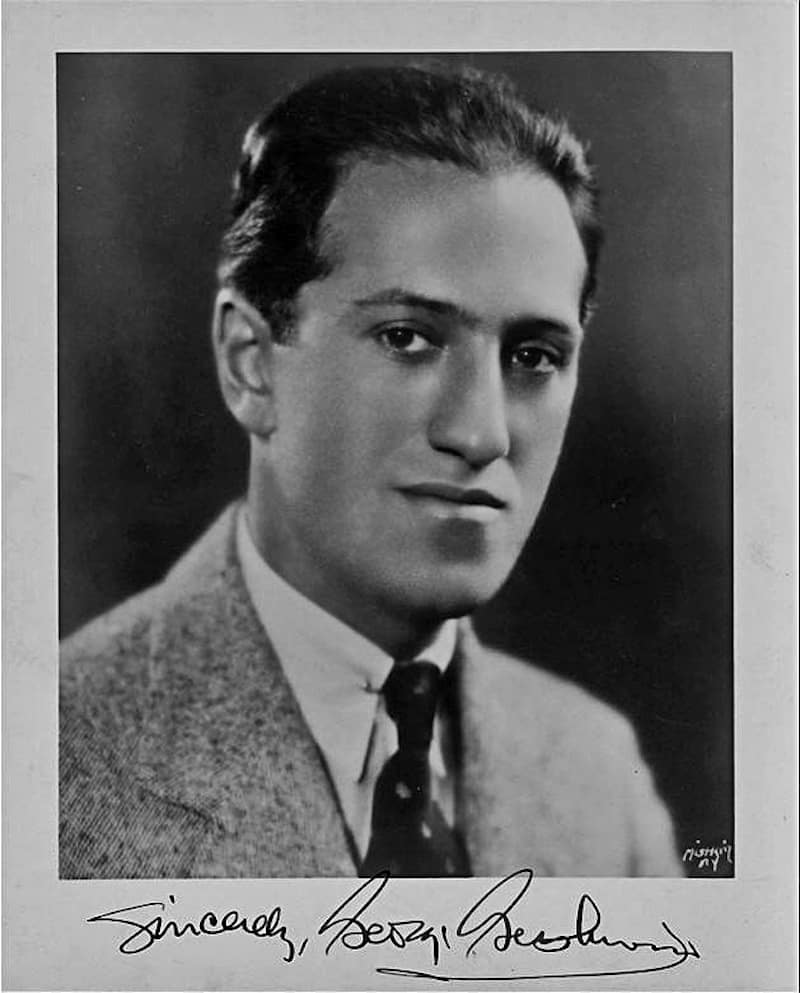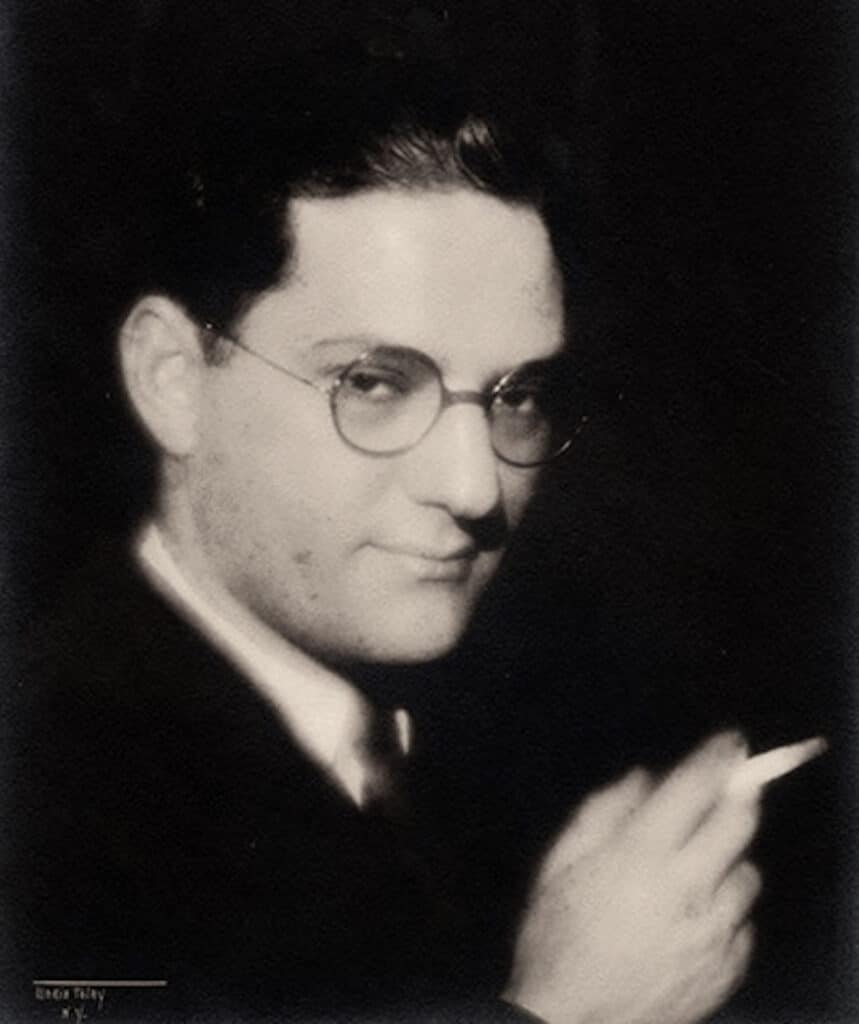George Gershwin was a man of many talents. His music transcended boundaries. He blended classical and popular music styles, making him a pioneer in the early 20th century.
His innovative approach to composition transformed the musical landscape. His timeless works, like “Rhapsody in Blue” and “An American in Paris,” became staples in both the jazz and classical repertoires.
But there’s more to this legendary composer than meets the eye. In this article, we’re going to delve deeper into the life and work of this musical genius. Prepare to be amazed and read on as we uncover 15 interesting facts about George Gershwin.
1. George Gershwin Was Not His Given Name

Indeed, the name George Gershwin is known worldwide — it’s synonymous with great American music. However, it may surprise some to know that this was not his birth name.
Gershwin was born Jacob Gershvin on September 26, 1898, in Brooklyn, New York. As a young boy, he showed a strong interest in music.
As he grew older and more serious about his musical career, he decided to change his name. He wanted a name that reflected his American identity and would be easier for the public to remember and pronounce.
So Jacob Gershvin became George Gershwin. The name change was not unusual for the time. Many immigrants and their children sought to assimilate into American culture by adopting more “American” sounding names.
2. He Had Humble Origins
Gershwin was the second of four children in a working-class family of Russian Jewish immigrants. His parents were Morris and Rose, and his siblings were Ira, Arthur, and the young sister, Frances.
His father worked a string of blue-collar jobs, including as a baker and a factory worker, to support his family. Often, the family would move residences with each change of their father’s work.
Despite this, the humble environment in which George grew up exposed him to a range of musical influences. These include the klezmer music of his Jewish heritage to the jazz and ragtime rhythms that were emerging in the streets of New York.
3. He Had No Formal Training
George Gershwin is known as one of the greatest composers in American history. That’s why it may come as a surprise to many that he had no formal training in music theory or composition.
When he was younger, his parents bought a piano intended for his older brother, Ira. However, it was George who showed an immediate affinity for the instrument. He began playing by ear, demonstrating an innate musical talent.
Gershwin’s formal education was limited and sporadic. His knowledge of music theory and composition was largely self-taught, supplemented by private lessons with individual teachers.
One of his early tutors was Charles Hambitzer, who provided Gershwin with a foundation in classical music. Despite his lack of formal training, he showed an incredible aptitude for composition. He studied the scores of classical masters, analyzing their structures and harmonies, and applied these techniques to his own works.
4. Gershwin Was A Piano Prodigy
As we mentioned above, when George Gershwin was still a child, his parents bought his brother a piano. Yet it was George who took to the instrument like a moth to a flame.
From the moment his fingers first touched the keys, it was evident that Gershwin was no ordinary musician. He had a natural talent. This raw talent, combined with his insatiable curiosity and passion for music, set him on the path to becoming a piano prodigy.
At just 15, Gershwin left school to play piano in various music stores, promoting new sheet music. This experience, while unconventional, was invaluable. It exposed him to a wide array of musical styles and honed his skills as a performer and composer.
5. He Worked As A Song Plugger
Before achieving fame for his compositions, George Gershwin worked as a song plugger. The term “song plugger” might not be familiar to many today. But during the late 19th and early 20th centuries, it was a common job in the music industry.
Song pluggers were essentially music promoters. They would perform new songs with the goal of getting people to buy the sheet music.
At 15, Gershwin dropped out of school and started working as a song plugger in New York’s Tin Pan Alley. He earned $15 a week, a modest wage even in those days, but the job offered him invaluable experience.
While working in Tin Pan Alley, Gershwin began composing his own songs. His first published song, “When You Want ‘Em, You Can’t Get ‘Em,” came out in 1916 when he was just 17 years old. Though it didn’t achieve much commercial success, it marked the beginning of his career as a composer.
6. He Made Piano Rolls
Gershwin made significant contributions to the world of music through his piano rolls. These were an early form of music recording technology used primarily in player pianos.
The system worked by punching holes into a roll of paper. These holes, when run through a mechanical reading device, would trigger the corresponding keys on the piano, essentially allowing for a “recorded” performance.
In the early 20th century, piano rolls were a popular means of disseminating music. They allowed people who didn’t play the piano to enjoy listening to it at home. For composers and performers, creating piano rolls was a way to reach a wider audience and gain popularity.
Gershwin was one of the musicians who embraced this technology. In his teens, he worked for various piano roll companies, including Standard Music Rolls in New Jersey, where he made and cut piano rolls. During this time, he recorded over a hundred piano rolls.
7. He Was A Genre-Blending Genius
Gershwin’s lack of formal training did not deter him from showcasing his remarkable talent for composition. He could create enchanting Broadway tunes as effortlessly as he composed complex orchestral pieces.
His masterpiece, Rhapsody in Blue, is perhaps the most striking example of his genre-blending prowess. This composition married elements of classical music and jazz — dubbed the first concert jazz — in an unprecedented manner, ushering in a new era in music.
The audacious venture catapulted Gershwin to international fame and firmly established him as a musical innovator. Throughout his career, he relentlessly pushed the boundaries of American music.
8. Gershwin Was Declined Tutorship
While he was in Paris during the mid-1920s, George Gershwin sought tutelage from Nadia Boulanger. She was one of the most respected music teachers of the 20th century. However, Boulanger declined to tutor him. This was a surprising turn of events, given the stature of both individuals in the music world.
She was known for her rigorous approach to teaching, and she had a long list of successful students who went on to have significant careers in music. However, she declined Gershwin because she believed she had nothing to teach him.
She felt that his unique style, which blended jazz and classical elements, was already fully formed and distinct. She feared that formal instruction might only serve to dilute his unique voice.
It is just as well that Boulanger declined. Had Gershwin been tutored in the classical ways, the impact he had on American music, and jazz in particular, might have been stifled.
9. He Had His Own Radio Program
One little-known aspect of George Gershwin’s career is his own radio program. Fittingly called Music by Gershwin, it aired in 1934 and was a significant event in the history of American music.
Music by Gershwin was not just a platform for him to showcase his compositions. It also served as an avenue for him to perform his pieces. It gave listeners the unique opportunity to hear the composer himself interpreting his own works.
This is particularly significant considering that recording technology was still in its early stages. Thus, opportunities to hear composers perform their own works were relatively rare.
The show included two 15-minute episodes complete with commercials. Some of the recordings from the Music by Gershwin are still available today. These include performances of songs like “Of Thee I Sing” and “Mine.”
10. Gershwin’s Brother Was A Lyricist

George Gershwin’s older brother was Ira Gershwin, an integral part of his musical journey. Ira was a gifted lyricist. Their collaboration resulted in some of the most memorable songs in American music history.
Ira began working with George in the early 1920s. While George was the melody creator, Ira had a talent for matching his brother’s music with fitting, meaningful words.
The Gershwin brothers’ collaboration led to numerous popular songs and Broadway hits. One of the most significant was the folk opera Porgy and Bess. The result was a powerful piece of musical theater that continues to be celebrated for its emotional depth and musical complexity.
11. He Suffered From Gastric Dysfunctions And Nausea
George Gershwin suffered from health problems throughout his life. Among these were gastric dysfunctions and nausea. The symptoms at first appeared mild but gradually worsened over time.
Gershwin’s health issues began to manifest in the form of what he referred to as “composer’s stomach.” He used this term to describe his recurring bouts of nausea and gastric dysfunctions. These symptoms were initially mild and intermittent. But as time went on, they became more severe and persistent.
Despite his health struggles, Gershwin continued to work tirelessly. In fact, he composed some of his most famous works during this period. However, his physical health inevitably impacted his ability to work and, over time, began to take a toll on his overall quality of life.
12. Gershwin’s Death Was A Shock
Gershwin’s health had been deteriorating for some time prior to his death. Aside from his “composer’s stomach,” he had also been experiencing severe headaches, mood swings, and coordination issues. These were initially diagnosed as emotional or psychological problems.
However, these symptoms were actually indicative of a much more serious condition. In early July 1937, Gershwin collapsed and was rushed to the hospital. After a series of tests, doctors discovered a large brain tumor. Despite undergoing surgery, Gershwin died two days later, on July 11.
At the age of 38, Gershwin’s death was indeed a shock to the world. He was one of the most celebrated composers of his time, with a career that spanned both popular and classical music. His untimely death was unexpected and left a significant void in the American music scene.
13. He Was A Prolific Composer
In his short-lived career, George Gershwin was quite a prolific composer. His body of work spanned various musical genres, not just Rhapsody in Blue and Porgy and Bess.
Gershwin also wrote a number of popular songs for Broadway and Hollywood. These include “Oh Lady, Be Good,” “Somebody Loves Me,” and “The Man I Love.” He also composed music for several musicals, including “Girl Crazy,” “Let ‘Em Eat Cake,” and “Pardon My English.”
Piano Concerto in F was the one and only concerto Gershwin composed. It was commissioned by Walter Damrosch, a conductor, and is more than 30 minutes long. Like Rhapsody in Blue, it infused classical forms with the energy and spontaneity of jazz.
14. He Received A Pulitzer Prize
In 1998, George Gershwin was posthumously awarded a special Pulitzer Prize. The award was given to commemorate the centennial year of his birth and to recognize his distinguished and enduring contributions to American music.
The posthumous Pulitzer Prize served not only as an acknowledgment of Gershwin’s talents. It was also a recognition of the lasting influence his music has had on subsequent generations of composers and musicians.
In addition to the Pulitzer Prize, that same year, he and his brother Ira were honored with a star on the Hollywood Walk of Fame.
15. A Prize Was Named After Him And Ira
The Library of Congress established the Gershwin Prize for Popular Song in 2007. This was in honor of the songwriting team of George and Ira Gershwin. In turn, this award is given to artists whose work exemplifies the standard of excellence that the Gershwins showed.
This prize is given to any genre, such as rock, jazz, country, and gospel. The recipient — whether composer or interpreter — has made significant contributions to popular music. They will be recognized in promoting song as a vessel of musical expression and cultural understanding.
The Gershwin Prize is the nation’s highest award for influence, impact, and achievement in the field of popular song. It celebrates the importance of popular music in shaping our culture and reflecting our shared human experience.
Summing Up Our List Of George Gershwin Facts
As you have read, George Gershwin was quite an influential figure in American music despite his short career. His life story is as compelling as his compositions.
He was an accomplished pianist and a revolutionary in the world of jazz and modern music, even with the struggles he faced with his health.
We hope you enjoyed our facts about Gershwin’s fascinating life and career. Let his legacy inspire you to follow your passions and make the most out of every opportunity that comes your way.


